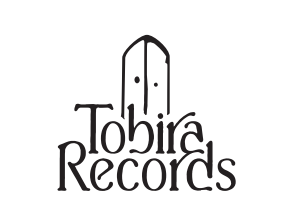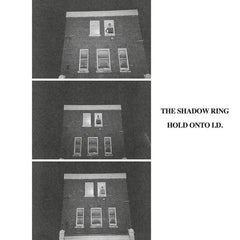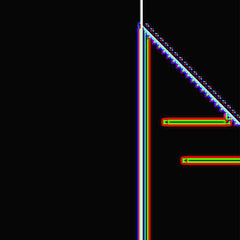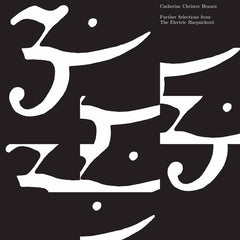Catherine Christer Hennix // Solo for Tamburium 2xLP / CD
- Availability:
スウェーデンの実験音楽家/哲学家Catherine Christer Hennix(1948-2023)のアーカイブシリーズ第4弾です。
以下、レーベルによる解説です。
"Hennixは自ら創作した楽器を演奏し、キーボード・インターフェイスで、精密に調律されたタンブラの88の録音からなる組曲をコントロールし、豊かなハーモニーの相互作用の連続的な流れを生み出している。ベルリンで開催されたMaerzMusik 2017で記録されたこの作品は、音の基本的な知覚効果を注意深く引き出し、厳密でカタルシスのある電子ドローンを形成している。密に重ねられた音色のテクスチャーと連続的な倍音の衝突が迷路のような音の風景を作り出し、聴く者をHennixの言う神の平衡、あるいは区別のない状態に突き落とす。
1960年代後半から、Hennixはミニマル・ミュージック、コンピューター・プログラミング、詩、彫刻、ライト・アートなど、革新的で膨大な作品を創作し、これらのメディアの技術的・概念的な限界を押し広げてきた。彼女はニューヨークのダウンタウン音楽学校の一員であり、ヘンリー・フリントやラ・モンテ・ヤングなど、その中心人物たちと幅広く活動してきた。70年代、Hennixは古典ヒンドゥスターニ音楽のキラーナ伝統の巨匠、パンディット・プラン・ナートの弟子として、ハーモニックサウンドの性質と使い方を学んだ。プラーン・ナートの特別にデザインされたタンブラは、彼女の集中的な研究の中心であり、楽器を注意深く調律し、連続的で均等な流れの中で鳴らすという献身的な実践でもあった。
1976年、ストックホルムのモデナ美術館で、Hennixは、その後の彼女の活動を決定づけた2つの画期的な作品を発表した。Hennix、弟のピーター、スウェーデンの打楽器奏者ハンス・イスグレンからなるグループ「デオンティック・ミラクル」とともに、ルネサンス・オーボエ、笙、ハーモニック・フィードバック・ディストーションのための一連のモーダルな作品を演奏した。この曲は、和声の構築と解消の重層的な相互作用から濃密な音のテクスチュアが徐々に浮かび上がってくる、Hennixの特徴的な演奏スタイルの始まりとなった作品である。
Solo for Tamburiumは、モーダル・ミュージック(ラーガ、マカム、ブルースなど)の非重力的なハーモニクスを調律されたキーボードにマッピングするという彼女の試みを、指摘的に再検討したものである。2017年にこの作品をデビューさせて以来、彼女は作品を発展させ続け、ニューヨークのブランク・フォームズや2022年のパリのピノー・コレクションなど、さまざまな文脈で作品を再構築し、発表してきた。Hennixにとって、モダリティをダイナミックなプロセスとしてアプローチすることは、究極的には瞑想的な実践である。それを通して、調和的な振動への身体的な同調は、認識論的に変容する状態を生み出し、知ることと存在することの新しい方法を開く。"
レーベルその他作品はこちら /// Click here to see more Blank Forms Editions releases available at Tobira.
------------------------
2x12" black vinyl.
Tracklist:
- Solo for Tamburium (01:18:00)
++
Blank Forms Editions:
"The fourth release in Blank Forms Editions’s initiative to chart the ever-expanding musical practice of Catherine Christer Hennix, Solo for Tamburium captures the composer’s most recent major work. Hennix plays an instrument of her own creation, a keyboard interface controlling a suite of eighty-eight recordings of precision-tuned tambura, creating a sweeping and continuous flow of rich harmonic interplay. This piece, documented in Berlin at MaerzMusik 2017, carefully draws upon the fundamental perceptual effects of sound, forming an exacting and cathartic electronic drone. Densely-layered timbral textures and continuous overtone collisions create a maze-like sonic landscape, thrusting the listener into what Hennix calls divine equilibrium or a distinctionless state of being.
Since the late 1960s, Hennix has created a massive and innovative body of work spanning minimal music, computer programming, poetry, sculpture, and light art—pushing the technical and conceptual boundaries of these media toward singular ends. She was part of the downtown music school in New York and has worked extensively with some of its key figures, including Henry Flynt and La Monte Young. In the ’70s, Hennix studied the nature and use of harmonic sound as a disciple of Pandit Pran Nath, a master of the Kirana tradition of classical Hindustani music. The exceptionally designed tamburas of Pran Nath were central to her intensive investigations, as was the devotional practice of carefully tuning and sounding the instruments in a continuous and even flow—both have guided her work with sound ever since.
In 1976, at Stockholm’s Moderna Museet, Hennix presented a pair of groundbreaking works that came to define her ensuing practice. With the Deontic Miracle—a group composed of Hennix, her brother Peter, and the Swedish percussionist Hans Isgren—she performed a series of modal compositions for Renaissance oboes, sheng, and harmonic feedback distortion. On this same occasion she premiered an equally significant body of solo work for keyboard, including the only public presentation of The Electric Harpsichord (1976), a piece that marks the beginning of Hennix’s characteristic style of playing, where dense sonic textures gradually emerge from the multilayered interplay of harmonic construction and dissolution.
Solo for Tamburium represents a pointed revisitation of her endeavor to map the non-gravitational harmonics of modal musics—among them raga, maqam, and the blues—onto a tuned keyboard. Since the debut of this piece in 2017 she has continued to develop the work, reshaping and presenting it in a variety of contexts, including at Blank Forms in New York and the Bourse de Commerce — Pinault Collection in Paris in 2022. For Hennix, to approach modality as a dynamic process is ultimately a contemplative practice. Through it, embodied attunement to harmonic vibration gives rise to epistemically transformative states, opening new ways of knowing and being."
Artist : Catherine Christer Hennix
Label : Blank Forms Editions
スウェーデンの実験音楽家/哲学家Catherine Christer Hennix(1948-2023)のアーカイブシリーズ第4弾です。
以下、レーベルによる解説です。
"Hennixは自ら創作した楽器を演奏し、キーボード・インターフェイスで、精密に調律されたタンブラの88の録音からなる組曲をコントロールし、豊かなハーモニーの相互作用の連続的な流れを生み出している。ベルリンで開催されたMaerzMusik 2017で記録されたこの作品は、音の基本的な知覚効果を注意深く引き出し、厳密でカタルシスのある電子ドローンを形成している。密に重ねられた音色のテクスチャーと連続的な倍音の衝突が迷路のような音の風景を作り出し、聴く者をHennixの言う神の平衡、あるいは区別のない状態に突き落とす。
1960年代後半から、Hennixはミニマル・ミュージック、コンピューター・プログラミング、詩、彫刻、ライト・アートなど、革新的で膨大な作品を創作し、これらのメディアの技術的・概念的な限界を押し広げてきた。彼女はニューヨークのダウンタウン音楽学校の一員であり、ヘンリー・フリントやラ・モンテ・ヤングなど、その中心人物たちと幅広く活動してきた。70年代、Hennixは古典ヒンドゥスターニ音楽のキラーナ伝統の巨匠、パンディット・プラン・ナートの弟子として、ハーモニックサウンドの性質と使い方を学んだ。プラーン・ナートの特別にデザインされたタンブラは、彼女の集中的な研究の中心であり、楽器を注意深く調律し、連続的で均等な流れの中で鳴らすという献身的な実践でもあった。
1976年、ストックホルムのモデナ美術館で、Hennixは、その後の彼女の活動を決定づけた2つの画期的な作品を発表した。Hennix、弟のピーター、スウェーデンの打楽器奏者ハンス・イスグレンからなるグループ「デオンティック・ミラクル」とともに、ルネサンス・オーボエ、笙、ハーモニック・フィードバック・ディストーションのための一連のモーダルな作品を演奏した。この曲は、和声の構築と解消の重層的な相互作用から濃密な音のテクスチュアが徐々に浮かび上がってくる、Hennixの特徴的な演奏スタイルの始まりとなった作品である。
Solo for Tamburiumは、モーダル・ミュージック(ラーガ、マカム、ブルースなど)の非重力的なハーモニクスを調律されたキーボードにマッピングするという彼女の試みを、指摘的に再検討したものである。2017年にこの作品をデビューさせて以来、彼女は作品を発展させ続け、ニューヨークのブランク・フォームズや2022年のパリのピノー・コレクションなど、さまざまな文脈で作品を再構築し、発表してきた。Hennixにとって、モダリティをダイナミックなプロセスとしてアプローチすることは、究極的には瞑想的な実践である。それを通して、調和的な振動への身体的な同調は、認識論的に変容する状態を生み出し、知ることと存在することの新しい方法を開く。"
レーベルその他作品はこちら /// Click here to see more Blank Forms Editions releases available at Tobira.
------------------------
2x12" black vinyl.
Tracklist:
- Solo for Tamburium (01:18:00)
++
Blank Forms Editions:
"The fourth release in Blank Forms Editions’s initiative to chart the ever-expanding musical practice of Catherine Christer Hennix, Solo for Tamburium captures the composer’s most recent major work. Hennix plays an instrument of her own creation, a keyboard interface controlling a suite of eighty-eight recordings of precision-tuned tambura, creating a sweeping and continuous flow of rich harmonic interplay. This piece, documented in Berlin at MaerzMusik 2017, carefully draws upon the fundamental perceptual effects of sound, forming an exacting and cathartic electronic drone. Densely-layered timbral textures and continuous overtone collisions create a maze-like sonic landscape, thrusting the listener into what Hennix calls divine equilibrium or a distinctionless state of being.
Since the late 1960s, Hennix has created a massive and innovative body of work spanning minimal music, computer programming, poetry, sculpture, and light art—pushing the technical and conceptual boundaries of these media toward singular ends. She was part of the downtown music school in New York and has worked extensively with some of its key figures, including Henry Flynt and La Monte Young. In the ’70s, Hennix studied the nature and use of harmonic sound as a disciple of Pandit Pran Nath, a master of the Kirana tradition of classical Hindustani music. The exceptionally designed tamburas of Pran Nath were central to her intensive investigations, as was the devotional practice of carefully tuning and sounding the instruments in a continuous and even flow—both have guided her work with sound ever since.
In 1976, at Stockholm’s Moderna Museet, Hennix presented a pair of groundbreaking works that came to define her ensuing practice. With the Deontic Miracle—a group composed of Hennix, her brother Peter, and the Swedish percussionist Hans Isgren—she performed a series of modal compositions for Renaissance oboes, sheng, and harmonic feedback distortion. On this same occasion she premiered an equally significant body of solo work for keyboard, including the only public presentation of The Electric Harpsichord (1976), a piece that marks the beginning of Hennix’s characteristic style of playing, where dense sonic textures gradually emerge from the multilayered interplay of harmonic construction and dissolution.
Solo for Tamburium represents a pointed revisitation of her endeavor to map the non-gravitational harmonics of modal musics—among them raga, maqam, and the blues—onto a tuned keyboard. Since the debut of this piece in 2017 she has continued to develop the work, reshaping and presenting it in a variety of contexts, including at Blank Forms in New York and the Bourse de Commerce — Pinault Collection in Paris in 2022. For Hennix, to approach modality as a dynamic process is ultimately a contemplative practice. Through it, embodied attunement to harmonic vibration gives rise to epistemically transformative states, opening new ways of knowing and being."
Artist : Catherine Christer Hennix
Label : Blank Forms Editions







